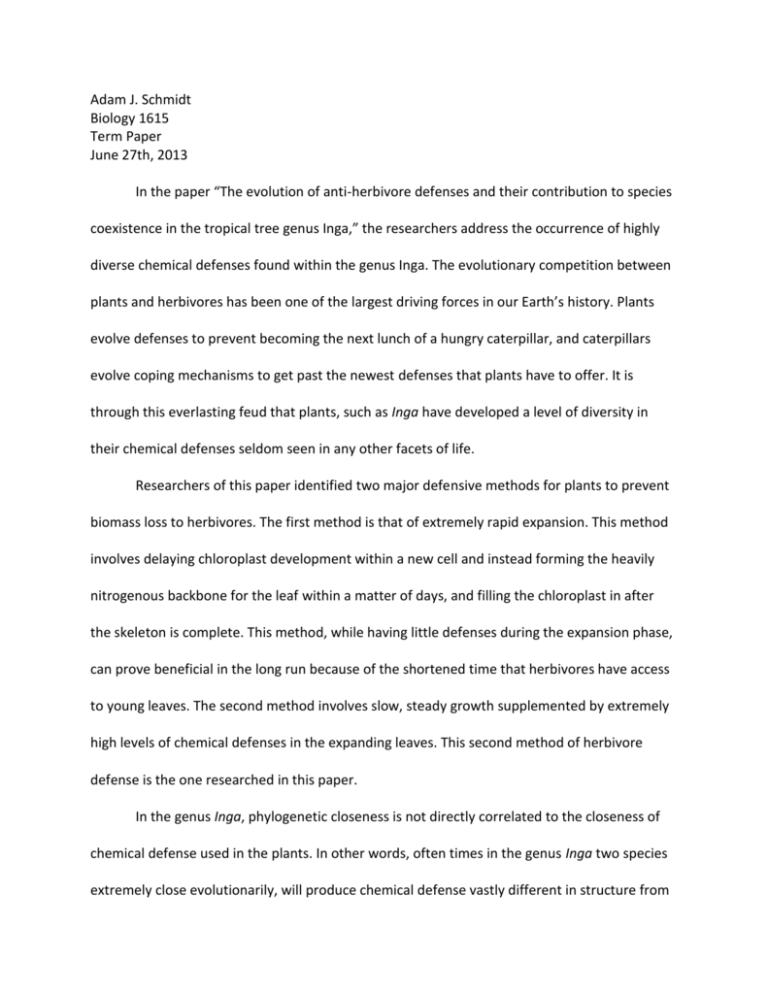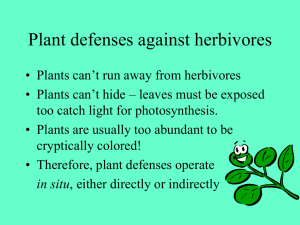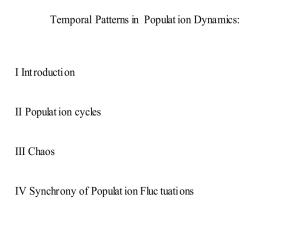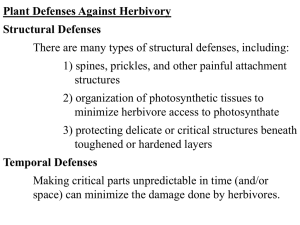File - Adam J Schmidt - SLCC BIO 1615
advertisement

Adam J. Schmidt Biology 1615 Term Paper June 27th, 2013 In the paper “The evolution of anti-herbivore defenses and their contribution to species coexistence in the tropical tree genus Inga,” the researchers address the occurrence of highly diverse chemical defenses found within the genus Inga. The evolutionary competition between plants and herbivores has been one of the largest driving forces in our Earth’s history. Plants evolve defenses to prevent becoming the next lunch of a hungry caterpillar, and caterpillars evolve coping mechanisms to get past the newest defenses that plants have to offer. It is through this everlasting feud that plants, such as Inga have developed a level of diversity in their chemical defenses seldom seen in any other facets of life. Researchers of this paper identified two major defensive methods for plants to prevent biomass loss to herbivores. The first method is that of extremely rapid expansion. This method involves delaying chloroplast development within a new cell and instead forming the heavily nitrogenous backbone for the leaf within a matter of days, and filling the chloroplast in after the skeleton is complete. This method, while having little defenses during the expansion phase, can prove beneficial in the long run because of the shortened time that herbivores have access to young leaves. The second method involves slow, steady growth supplemented by extremely high levels of chemical defenses in the expanding leaves. This second method of herbivore defense is the one researched in this paper. In the genus Inga, phylogenetic closeness is not directly correlated to the closeness of chemical defense used in the plants. In other words, often times in the genus Inga two species extremely close evolutionarily, will produce chemical defense vastly different in structure from each other. Closely related plants producing vastly different chemicals is a phenomena at the heart of the diversification of the genus Inga. The mechanism that these researchers believe best explains this occurrence is that Inga species share a common ancestor with the genetic blueprint to make a vast array of chemical defenses. As evolution progressed, differing plant species activated different chemicals in their genes to find a niche in their environment. With the increase of chemical diversity in the genus, the chance that the defenses will be more effective increases. In order to test this phenomenon, researchers catalogued numerous Inga from South America, they then created both a phylogenetic tree relating all of the species and a tree relating the relative similarity of chemical defenses used in each plant. What they found was that Inga in the plots of land had a greater than random diversity among chemical defenses used in the area. This discovery has important implications. With greater than random diversity of chemical defenses (but not of phylogenetic diversity) we can now conclude that finding a niche in terms of ability to fend of potential herbivores is a leading factor in evolution in this genus. If a plant can distinguish itself from others chemically, it has a lower likelihood of being eaten by herbivores that are capable of eating other plants in the area. By increasing the diversity of defenses in any particular area, it improves the chances of survival not just for any singular plant, but for the area as a whole, as it can no longer be wiped out by any one specialist herbivore. The research done by these University of Utah professors has illuminated a largely unknown portion of evolutionary biology in terms of botanical chemistry. With continued research in this field, we will grow ever closer to truly understanding what drives plants and herbivores in their unceasing fight to conquer one another.











